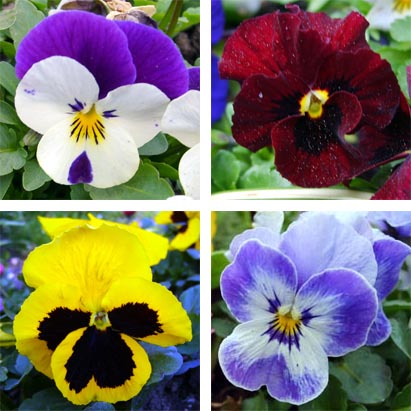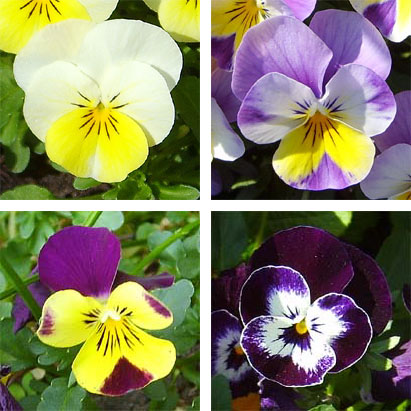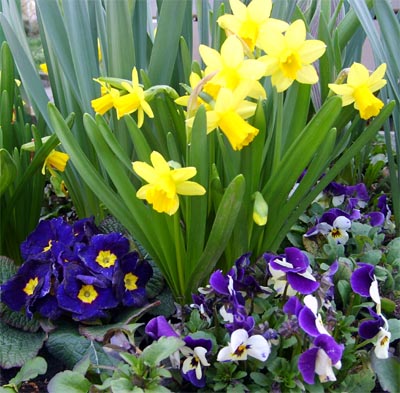Pansy Flowers
Pansy flowers are very popular garden flowers. There are almost countless pretty pansy cultivars that come in various colours, sizes and markings.


The flowers resemble a face (well, maybe you have to be a bit imaginative about this) and are either uniformly coloured or multi-colored with a wide color range.
Lots of gardeners like to fill their gardens with these beautiful plants and many communities use them for adorable street decorations.

Gardening Pansies
People await these colorful spring messengers when winter is ending. Pansy flowers are true spring plants blooming at the same time as daffodil flowers, tulip flowers, primrose flowers, lenten roses, siberian squill flowers, snowdrop flowers, winter aconites, crocus flowers or any other spring flowers.
Although they are quite robust and are flowers for all seasons in some locations, they tend to wilt in hot summers but bloom again in the late season until harsh frost and freezing sets in. In fall, they look beautiful when planted together with red of white erica flowers.
Planting Pansies
Planting pansies is not difficult. It is easiest to buy bedding pansy plants. Choose your preferred colours, markings and sizes, especially those that match with your other garden or balcony plants and your overall garden theme and design. Enjoy being creative and experimental!
Prepare the soil with organic matter or fertilizer. There is no specific pansy fertilizer. A simple all-purpose fertilizer will do.
Dig the planting holes about 15 to 25 centimetres (six to ten inches) apart. This will give the individuals plants enough space to grow and thrive.
Gently place the plants into the prepared holes. Repotting is always stressful for plants! Add earth and water them thoroughly. They need some adjustment time. After that, they will flourish and add colours and scents to your garden!
Growing from Viola Seeds
You could also grow your pansies from viola seeds (pansy seeds). Yet, this is quite some work and requires time and patience. Keep in mind that when planting full-blooming bedding plants you can instantly enjoy the grown plants and the colourful, scented flowers.
Nevertheless, if you favour growing viola plants from seeds, then go ahead! This is may also be a money saver (certainly if you buy the seeds in bulk)!
First of course, buy the seeds that you prefer. There are so many that you can choose from!
I suggest that you start growing the seeds in July to August. Then, the pansy flowers will be blooming in early spring together with other spring flowers. You will definitely enjoy all the colours popping up in your garden after a pale winter season!
It is best to grow the seeds indoors or in a green house, where the temperature will be not to cold and not to hot. Place them in clean containers with a germinating mix for seed-starting. You can get the germinating mixture at your local garden supply shop.
First, water the seedbed thoroughly until it is drained. Then, place the seeds about four centimetres (a little bit less than an inch) deep and cover it with the germination mixture. Water them again generously and place it somewhere in the dark (viola seeds need darkness to germinate). Check the containers regularly and keep them moist. They then germinate within two to three weeks.
Place the germinated seeds in a light-filled room as soon as see green tips breaking the germinating mixture surface. The plants will grow and produce leaves. Then it is time to replant them about two and a half centimetres (one inch) apart in a larger pot. Place them in a sunny but cool location and eventually fertilize them with a diluted all-purpose soluble liquid fertilizer (about two times per week).
Transplant the pansies in your garden to their permanent locations when the young plants have grown strong enough. Enjoy and smile!
Growing Pansies and Pansies Care
Growing pansies and a good pansies care is not hard to provide. Pansy flowers are rather robust once they have successfully established themselves in their permanent locations. They do like to be kept in a moist environment. Water them once a week (preferably in the morning) and give them a diluted, soluble, all-purpose fertilizer about three to four times a year.
Also, try to keep the weeds away. Weeds will compete for nutrients and moisture and are therefore harmful for cultivated garden plants.
In summer when it gets to hot they tend to wilt. Just let them be but remove the fading flowers. They will start thriving again when the temperatures drop again and in fall season. They tolerate some light frost in winter. Sometimes they freeze in winter when it gets sub-zero cold over a longer period of time. It all depends on your location and on the robustness of the plants themselves.
Speaking for myself: I planted two different sorts of pansy flowers last fall. One sort did not survive the cold winter days; the other sort suffered but is still blooming and starts thriving again (it is end of February/early March).
As always, nature has its own will!
Return from Pansy Flowers to the Plant and Flower Guide